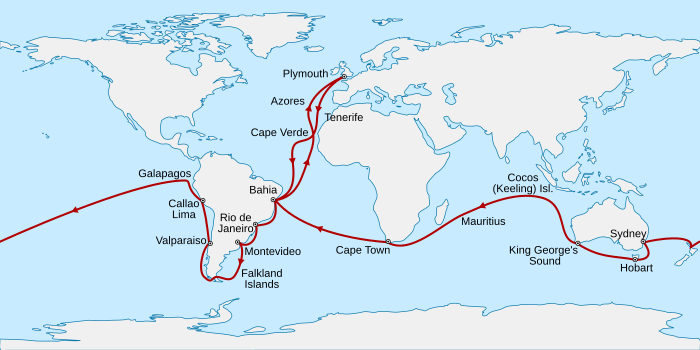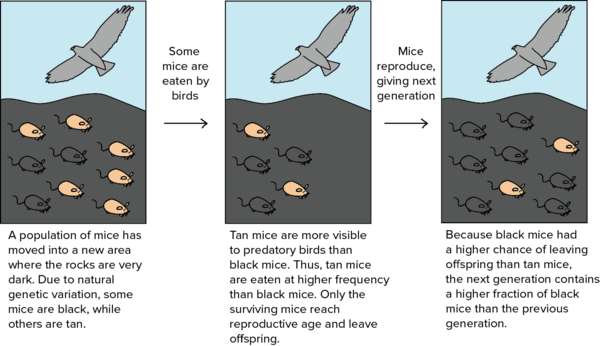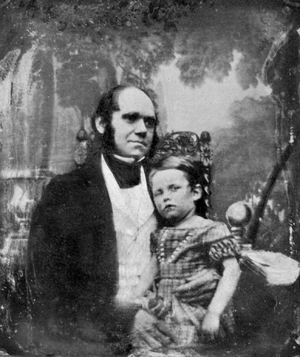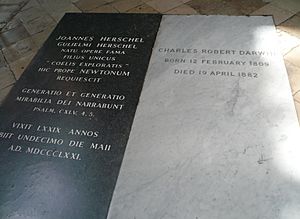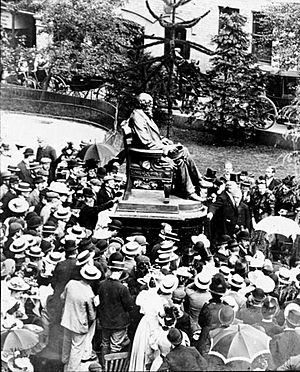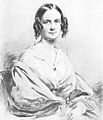Charles Darwin facts for kids
Quick facts for kids
Charles Darwin
|
|
|---|---|
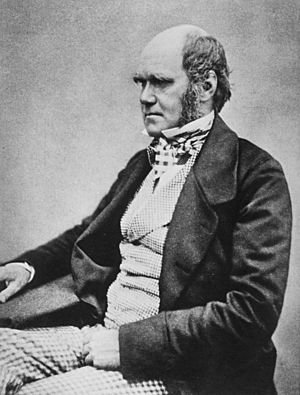
Darwin, c. 1854 when he was working towards publication of On the Origin of Species
|
|
| Born |
Charles Robert Darwin
February 12, 1809 The Mount, Shrewsbury, Shropshire, England
|
| Died | April 19, 1882 (aged 73) |
| Known for | The Voyage of the Beagle On the Origin of Species |
| Spouse(s) | |
| Children | 10 |
| Scientific career | |
| Fields | Natural history, geology |
| Signature | |
 |
|
Charles Robert Darwin (February 12, 1809 – April 19, 1882) was an English naturalist. He was born in Shrewsbury, Shropshire. He is famous for his work on the theory of evolution.
Darwin's book On the Origin of Species was published in 1859. In it, Darwin shared evidence that evolution has happened. He also tried to explain how evolution works. Darwin's idea for evolution is called natural selection. On the Origin of Species says that evolution and natural selection help us understand all the different kinds of life on Earth.
Contents
Early Life and Education
Charles Robert Darwin was born in Shrewsbury, Shropshire, on February 12, 1809. He was born at his family's home, The Mount. He was the fifth of six children. His father was Robert Darwin, a rich doctor. His mother was Susannah Darwin.
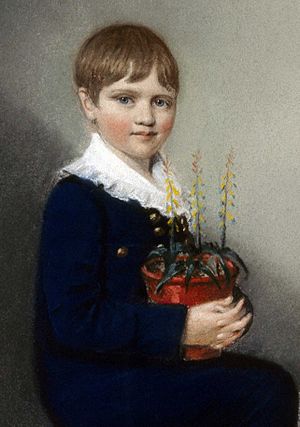
When Charles was eight, he already loved natural history and collecting things. In 1817, he joined a day school. His mother died in July of that year. In September 1818, he went to Shrewsbury School as a boarder. His older brother Erasmus was already there.
In 1825, Darwin spent the summer helping his father as a doctor's apprentice. He helped treat poor people in Shropshire. Then, in October 1825, he went to the University of Edinburgh Medical School. Darwin did not like medical school and didn't study much. He learned taxidermy (preparing animal specimens) from John Edmonstone. John was a freed slave who had traveled in the South American rainforest.
Darwin's father thought Charles wasn't serious about medicine. So, he sent Charles to Christ's College, Cambridge. Charles was meant to study to become an Anglican country parson (a church leader). Darwin stayed at Cambridge until June 1831. He planned to visit Tenerife with friends after graduating. He wanted to study natural history in the tropics. To get ready, he took a geology course with Adam Sedgwick. On August 4, Darwin traveled with Sedgwick to map rocks in Wales.
Voyage of the HMS Beagle
Darwin spent almost five years on a Royal Navy exploring ship, the HMS Beagle. The trip lasted from December 1831 to October 1836. At that time, Britain had the biggest navy and a huge empire. One of the Beagle's jobs was to make maps of coastal areas. Darwin's job was to collect and write notes about the animals, plants, and geology of the places they visited.
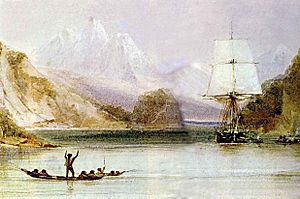
Darwin collected things everywhere the ship stopped. He found huge fossils of recently extinct mammals. After an earthquake in Chile, he noticed the land had risen. He knew about raised beaches high in the Andes mountains. These beaches had seashell fossils and trees that once grew on sandy shores. He saw that Earth was always changing. Land was rising in some places and sinking in others. He collected birds and insects. He sent them back to Cambridge for experts to identify.
Darwin was the first dedicated naturalist to visit the Galápagos Islands, off the west coast of Ecuador. He saw that some birds were like mockingbirds on the mainland. But they were different enough to be separate species (groups of similar living things). He started to wonder how so many new species came to be on these islands.
When Darwin returned to England, he helped edit scientific reports about the voyage. He also wrote a personal journal, which is now famous as The Voyage of the Beagle. It's a well-known travel diary about natural history.
Darwin's Theory
Before Darwin's Ideas
Before the 1800s, people believed in a theory called Catastrophism. This idea said that species died out because of big disasters. New species then appeared "out of nothing." The extinct species could be found as fossils. These new species were thought to be unchangeable. This idea partly matched the story of the Flood in the Bible.
In the early 1800s, new ideas began to challenge Catastrophism. One important idea came from Jean-Baptiste Lamarck (1744-1829). He noticed that new generations inherited traits from their ancestors. He thought that traits or organs got stronger with more use. He also thought they got weaker or disappeared if not used. Lamarck suggested that parents passed these changes directly to their children.
Evolution by Natural Selection
While on the H.M.S. Beagle and later in London, Darwin read the ideas of Rev. T.R. Malthus. Malthus realized that humans could double their population every 25 years. But this didn't happen. He thought it was because a struggle for existence (or resources) limited their growth. If populations grew too much, famine, wars, and diseases caused more deaths. Darwin knew all living things could increase their numbers. He began to think about why some survived and others didn't. His answer took many years to develop.
Darwin started thinking about this in 1838. But it took 20 years for his ideas to become public. By 1844, he had written a draft of his main ideas in his notebook. Historians believe he didn't talk about his theory because he feared public criticism. He knew his theory, which didn't mention religion, challenged the Book of Genesis. In 1858, he learned that another biologist, Alfred Russel Wallace, had similar ideas about natural selection. Darwin and Wallace's ideas were first published together in a journal in London in 1858. Then, Darwin published his full theory in a book the next year. The book's full name was On the Origin of Species by Means of Natural Selection, or the preservation of favored races in the struggle for life. It is usually just called The Origin of Species.
The theory of evolution says that all living things on Earth, including plants, animals, and tiny microbes, came from a common ancestor. They changed slowly over many generations. Darwin suggested that living things changed over time through natural selection. Those that fit best into their environment have the best chance to survive and have babies. Fitting into your environment is called adapting. Those that are not as well-adapted often don't survive. If they don't survive well enough to have young, they don't pass on their genes. This way, the species slowly changes. Only the strongest genes get passed to the next generations. This is sometimes called "survival of the fittest."
The first chapter of Origin talks about domesticated animals, like cows and dogs. Darwin reminded readers how much humans had changed their domestic animals, which were once wild. These changes were made by selective breeding. This means choosing animals with good traits to breed from. This was done generation after generation until our modern breeds were made. Darwin suggested that what humans did on purpose could happen in nature over a much longer time. He suggested the same for plants and other animals.
Darwin wrote several other books, and most of them are also very important.
Family Life
In 1843, Darwin, who already had two children with his wife Emma, bought Down House. This was in the village of Downe, Kent. The Darwins had ten children in total. Sadly, two of them died when they were very young. Charles was a loving father to his children.
Of his children who lived, George, Francis, and Horace became important scientists. They were even made Fellows of the Royal Society. George was an astronomer, Francis was a botanist (studied plants), and Horace was a civil engineer. All three were later knighted. Another son, Leonard, became a soldier, politician, and economist.
Death and Funeral
In 1882, doctors said Darwin had "angina pectoris." This meant he had heart problems.
He died at Down House on April 19, 1882. His last words were to his family. He told Emma, "I am not the least afraid of death—Remember what a good wife you have been to me—Tell all my children to remember how good they have been to me." While she rested, he told his children Henrietta and Francis, "It's almost worthwhile to be sick to be nursed by you."
His funeral was held on Wednesday, April 26. Thousands of people came, including family, friends, scientists, thinkers, and important officials.
Legacy
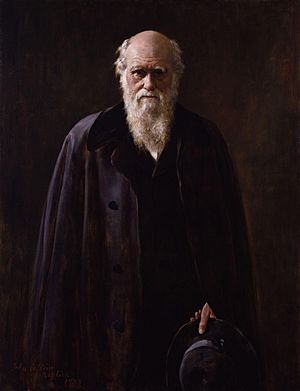
By the time he died, Darwin and his fellow scientists had convinced most people that his theory of evolution was right. He was seen as a great scientist who had changed scientific ideas forever.
Commemoration
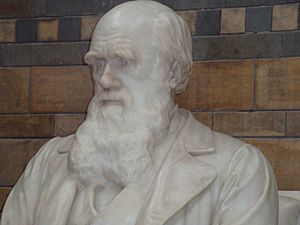
Many places were named after Darwin during his lifetime. An area of water near the Beagle Channel was named Darwin Sound. This was done by Robert FitzRoy after Darwin and others saved their boats from a giant wave. The nearby Mount Darwin in the Andes was named on Darwin's 25th birthday. When the Beagle was exploring Australia in 1839, Darwin's friend John Lort Stokes found a natural harbor. The ship's captain, Wickham, named it Port Darwin. A nearby town was renamed Darwin in 1911. It became the capital city of Australia's Northern Territory.
Stephen Heard found 389 species that have been named after Darwin. For example, a group of tanagers (birds) similar to those Darwin found in the Galápagos Islands became known as "Darwin's finches" in 1947. This started the stories about how important they were to his work.
Darwin's work continues to be celebrated with many books and events. The Linnean Society of London gives out the Darwin–Wallace Medal since 1908. Darwin Day is celebrated every year. In 2009, worldwide events marked the bicentenary (200th anniversary) of Darwin's birth. They also celebrated the 150th anniversary of On the Origin of Species being published.
Darwin has been honored in the U.K. by the Bank of England. His picture, along with a hummingbird and HMS Beagle, is on the back of the £10 banknotes.
A life-size statue of Darwin sitting can be seen in the main hall of the Natural History Museum in London.
A statue of Darwin is in front of Shrewsbury Library. This building used to be Shrewsbury School, where Darwin went as a boy. It was put there in 1897. Another statue of Darwin as a young man is at Christ's College, Cambridge.
Darwin College, a college for advanced studies at Cambridge University, is named after the Darwin family.
Darwin's Down House and its contents are now open to the public for visits.
Charles Darwin quotes
- “A scientific man ought to have no wishes, no affections, – a mere heart of stone.”
- “The mystery of the beginning of all things is insoluble by us; and I for one must be content to remain an agnostic.”
- "One general law, leading to the advancement of all organic beings namely, multiply, vary, let the strongest live and weakest die."
- "I am turned into a sort of machine for observing facts and grinding out conclusions."
Interesting facts about Charles Darwin
- Charles Darwin was born in England on the same day that Abraham Lincoln was born in Kentucky.
- He studied and ate exotic (rare or unusual) animals both at school and in his travels.
- Charles dropped out of medical school.
- Charles married his first cousin, Emma.
- He wrote a pro/con list on the subject of marriage.
- Darwin played backgammon with his wife every evening between 8 and 8:30 PM.
- The highest peak of Tierra del Fuego is named after him.
- His work On the Origin of Species by Means of Natural Selection was published twenty years after his travels.
- Herbert Spencer is the philosopher who coined the term "Survival of the Fittest," even though we think of Darwin when we hear that phrase.
Related pages
Images for kids
-
Bicentennial portrait by Anthony Smith of Darwin as a student, in the courtyard at Christ's College, Cambridge where he had rooms
-
Darwin (right) on the Beagle's deck at Bahía Blanca in Argentina, with fossils; caricature by Augustus Earle, the initial ship's artist.
-
In mid-July 1837 Darwin started his "B" notebook on Transmutation of Species, and on page 36 wrote "I think" above his first evolutionary tree.
-
Darwin chose to marry his cousin, Emma Wedgwood.
-
Darwin's "sandwalk" at Down House was his usual "Thinking Path."
-
Darwin aged 46 in 1855, by then working toward publication of his theory of natural selection. He wrote to Joseph Hooker about this portrait, "if I really have as bad an expression, as my photograph gives me, how I can have one single friend is surprising."
-
During the Darwin family's 1868 holiday in her Isle of Wight cottage, Julia Margaret Cameron took portraits showing the bushy beard Darwin grew between 1862 and 1866.
-
An 1871 caricature following the publication of The Descent of Man was typical of many showing Darwin with an ape body, identifying him in popular culture as the leading author of evolutionary theory.
-
Statue of Darwin in the Natural History Museum, London
See also
 In Spanish: Charles Darwin para niños
In Spanish: Charles Darwin para niños


